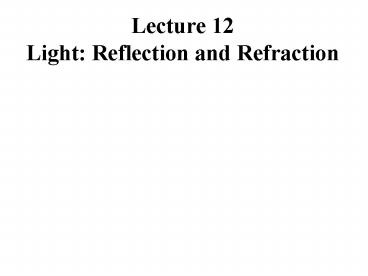Lecture 12 Light: Reflection and Refraction - PowerPoint PPT Presentation
Title:
Lecture 12 Light: Reflection and Refraction
Description:
Lecture 12 Light: Reflection and Refraction Chapter 22.1 22.4 Outline History of Studies of Light Reflection of Light The Law of Refraction. Index of Refraction. – PowerPoint PPT presentation
Number of Views:328
Avg rating:3.0/5.0
Title: Lecture 12 Light: Reflection and Refraction
1
Lecture 12Light Reflection and Refraction
Chapter 22.1 ? 22.4
Outline
- History of Studies of Light
- Reflection of Light
- The Law of Refraction. Index of Refraction.
2
Towards the Nature of Light
Newton considered light as a stream of particles
and explained reflection and refraction (1660s).
Huygens proved that these phenomena can be
understood if light is waves (1670s).
Grimaldi (ca. 1660) and Young (1801)
experimentally demonstrated that light exhibits
diffraction and interference.
Maxwell (1865) predicted that light is a form of
electromagnetic waves. Work of Hertz (1880s),
Planck (1900), and Einstein (1905) showed that
light has dual nature.
3
What is Light?
Dual nature means that under some conditions
light behaves as a wave, while under others as a
particle.
Light does not show properties of both wave and
particle in the same experiment.
Particles of light are called photons.
E ? energy of a photon h 6.63 10?34 J s ?
Planck constant f ? frequency of the
electromagnetic wave
E h f
4
Geometric Optics
- Light travels in a straight-line path in a
homogeneous medium. - At a boundary between 2 different media the
light - is reflected
- passes into the other medium (material)
- does both (partially)
After entering a different medium, light
continues traveling in a straight-line path.
Definition wave front is a surface of a wave
with the same phase and amplitude.
5
Reflection of Light
There are types of reflection specular and
diffuse.
Reflection off a smooth surface (average distance
between irregularities is smaller than the
wavelength of the incident light) is specular.
A line perpendicular to the surface is called a
normal.
Picture
The angle of incidence equals the angle of
reflection.
?? ?
6
Refraction of Light
Refraction is bending of light at a boundary
between two different media.
The incident, reflected, and refracted rays all
lie in the same plane. The path of a light ray
through a refracting surface is reversible.
sin ?2 v2 ?? ? constant sin ?1 v1
7
The Law of Refraction
Any medium is characterized by an index of
refraction (n).
c speed of light in vacuum n ? ?
??????????? v speed of light in a
medium
The frequency (f) of light, traveling between
different media is constant.
Since f ? v, the wavelength of a light ray in
media with different indices of refraction should
change.
8
The Law of Refraction
?1 v1 c/n1 n2 ? ? ??
? ?2 v2 c/n2 n1
v1f ?1
?
f1 f2
v2f ?2
Index of refraction is the ratio of the
wavelength of light in vacuum and its wavelength
in a medium
n ?0/ ?n
The angle of refraction is related to the index
of refraction by Snells law of refraction.
n1 sin ?1 n2 sin ?2
9
A Refraction Problem
Problem A ray of light strikes a flat block of
glass (n1.50) at an angle of 30o with the normal.
?1 30o
Find angles of incidence and refraction at each
surface and the distance (d) of shift from the
initial direction.
x1
?2
l 2cm
sin ?2 (n1/n2) sin ?1
n1 1 n2 3/2
d (x1 ? x2) sin (90o ? ?1)
d
?1
x1 l tan 30o
?2 19.5o, x1?x20.45cm d 0.39 cm
x2
x2 l tan ?2
10
Summary
- Light is a form of electromagnetic waves. It
shows properties of both a wave and a particle. - Reflection and refraction are wave properties of
light. - For specular reflection, the angle of incidence
equals to the angle of reflection - Index of refraction is a property of a medium. It
is a measure of the speed of light in a certain
medium.































